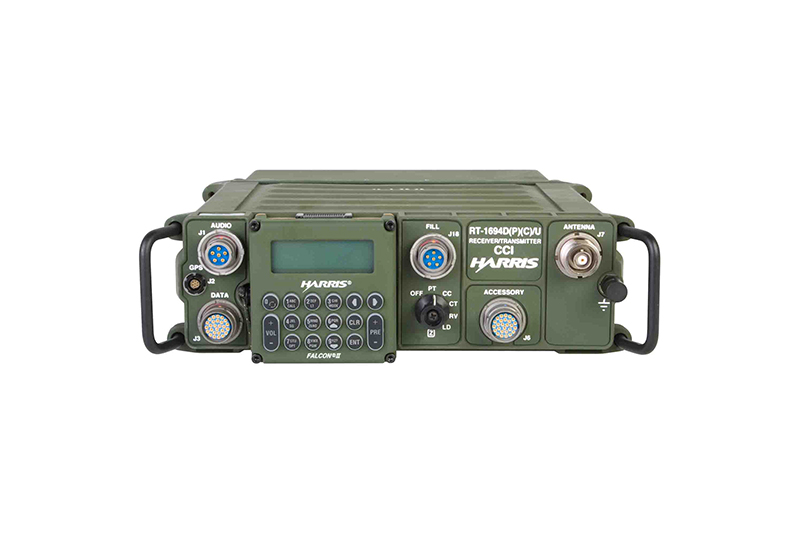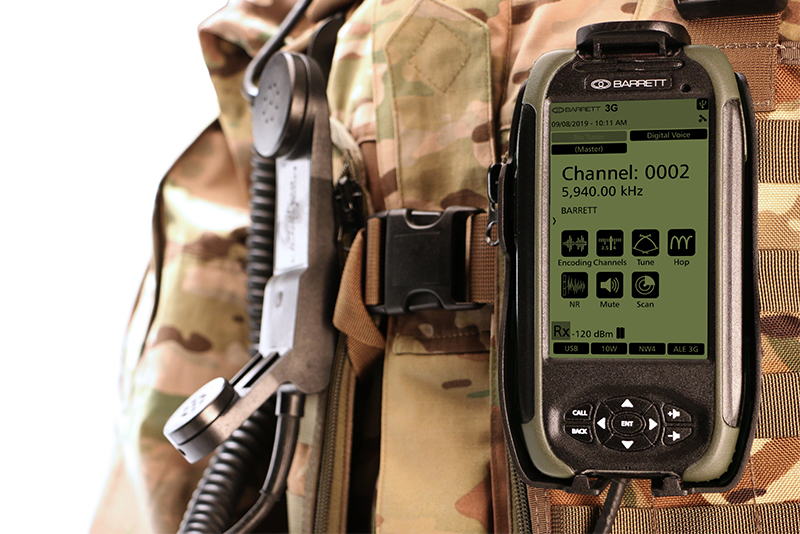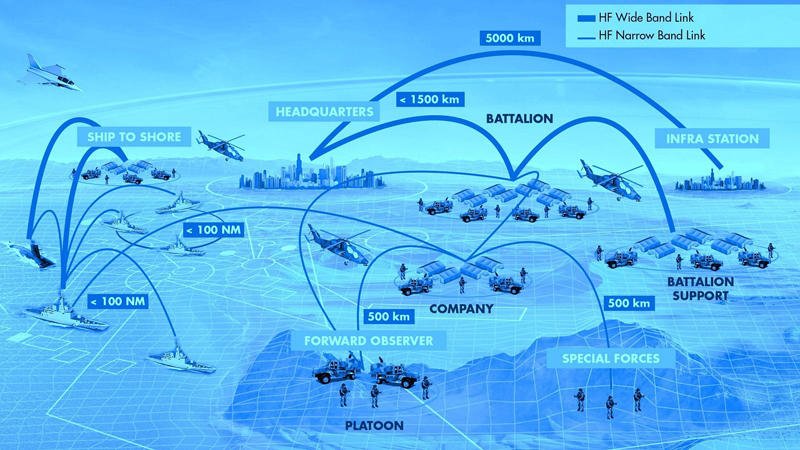
Discovered almost one century ago, High Frequency (HF) radio has never lost its appeal thanks to its ability to move traffic across long distances, and its resilience to electronic attack.
High Frequency (HF) radio
Confusingly, High Frequency (HF) radio is also known as shortwave radio. The same terms cover radio traffic using a waveband of three megahertz/MHz to 30MHz. The shortwave moniker comes from the length of the radio waves but this can be deceptive. Three megahertz radio transmissions have a wavelength of almost 100 metres/m (328.1 feet/ft), reducing to almost ten metres (32.8ft) for 30MHz transmissions.
At first blush such wavelengths seem rather long. The reason for the name was that in the heady days of radio in the early 20th century, shortwave did indeed use transmissions much shorter than long wave and medium wave. Medium wave transmissions, in a waveband of 300 kilohertz (kHz) to three megahertz (MHz), has wavelengths of 999.3m (3,278.5ft) to 100m, with long wave communications using transmissions of 3kHz (99.8 kilometres/62 miles) and 300kHz, although exact definitions of the upper limit of long wave remain fluid.
The breakthrough in shortwave radio occurred in June and July 1923. Guglielmo Marconi, the father of radio, working with the British radio pioneer Charles Samuel Franklin, performed a series of experimental radio transmissions using a 3MHz frequency. These were made from Poldhu Wireless Station in Cornwall, southwest England, to the yacht Elettra, owned by Marconi, in the Cape Verde Islands, 2,337.1 nautical miles (nm)(4,228.3km) away off the coast of West Africa.
Further experiments took place in September 1924 during which transmissions on a frequency of 12.4MHz were performed, this time transmitting between Poldhu and Marconi’s yacht moored off Beirut. Two months before, Marconi had concluded contracts with the UK General Post Office to provide shortwave telegraph services between London and Australia, Canada, India and South Africa. The appeal of shortwave communications then continued to spread largely unabated until the resurgence of underwater intercontinental telecommunications cables from the mid-1950s, and the advent of Satellite Communications (SATCOM) triggered by the launch of the US’ Project SCORE (Signal Communications by Orbiting Relay Equipment); the world’s first purpose-built communications satellite, on 18 December 1958.
HF communications
Despite advances in the undersea cable and SATCOM domains, HF communications are still in use. For example, radio amateurs use parts of the HF band to communicate with their contacts around the world. More mysteriously, so-called ‘Numbers Stations’ which transmit audible series of numbers via automated broadcasts, regularly employ the HF waveband. Such transmissions are thought to be used by governments and intelligence agencies for coded communications with intelligence agents around the world. The military is also an avid user of HF.
Martin Johnson, director of business development at Barrett Communications believes that HF has remained attractive to militaries because “once you own HF radio equipment, you can deploy it in any way you want. It does not rely on satellite links or infrastructure from any third party.” HF radios can be used in man-pack, fixed or vehicular forms making them highly versatile. HF is also highly cost-effective compared to SATCOM; he argues. The latter requires dedicated terminals and antennas, not to mention the satellites themselves, or leased satellite bandwidth if the nation in questions does not possess its own spacecraft.
The only expense with HF communications is the radio itself: “HF capability is being increasingly adopted as an alternative to Satellite Communications (SATCOM),” said Nuno Cordeiro, sales engineer at EID.
Moreover HF can penetrate jungle and forest tree canopies which can physically obscure Very/Ultra High Frequency (V/UHF) communications (30MHz to three gigahertz). Therefore in the Asia-Pacific “where forests and jungle are an obstacle to standard transmissions, HF remains the only way to keep forces connected,” notes a written statement supplied to AMR by Thales.
The lack of required infrastructure for HF has benefits to users in the Asia-Pacific: “Light HF infrastructure enables a quick deployment to restore communications in damaged environments, in the case of natural disasters” the statement continued. Sadly the Asia-Pacific is no stranger to calamities. As this article was being written in mid-October, Typhoon Hagibis had killed almost 100 people in the Kanto region of Japan which includes Tokyo. The ability to rapidly activate beyond line-of-sight communications in the wake of such disasters can save lives and accelerate the clean-up.
Faisal Munir, vice president and general manager of international sales for tactical communications at L3Harris adds that “most countries in the Asia-Pacific have a large land mass with a few densely populated cities. Armies find it difficult to provide communications coverage with standard commercial or line-of-sight radios.”
Munir continues that HF is particularly attractive to special forces in the region. Furthermore, HF is routinely used to support command and control nets at the battalion, brigade and division headquarters levels. L3Harris counts the armies of the Philippines and Pakistan as regional forces using the firm’s AN/PRC-150C and RF-7800H-MP HF man-pack radios.

The Pros and Cons of HF
Why is HF so attractive? Put simply, ionospheric reflection. The ionosphere is an upper layer of the atmosphere between 60km (37.3 miles) and 1,000km (621.5 miles) altitude. This is electrically charged layer cannot be penetrated by HF transmissions. Instead, they hit the ionosphere and bounce back to Earth which allows HF communications to achieve their intercontinental ranges.
However, HF has trade-offs. The time of day can have an effect on their over-the-horizon ranges. During the day, HF transmissions of twelve megahertz and above can travel further than those below and vice versa at night. The ionosphere itself is split into layers. The D layer, at an altitude of 60km to 90km (60 miles) only forms during daytime when sunlight breaks atoms into free electrons and ions. Solar flares also make their presence felt. This phenomenon is caused when the sun spits out plasma beyond the corona. These eruptions are accompanied by significant amounts of radiation. If the ejection of the material is in the direction of earth, particles generated by these eruptions can penetrate the ionosphere. This can cause the auroras associated with the Arctic and Antarctic regions and, given the disturbance it causes in the atmosphere, can seriously disrupt HF.
The other disadvantage of HF is that the weight of communications it can carry are restricted compared to V/UHF. Up until quite recently, for example, HF radio could be restricted to carry data at rates of up to 9.6 kilobits-per-second (kbps). This is in distinct contrast to the megabit-per-second (Mbps) data rates which can be carried by UHF communications.
Barrett has enjoyed healthy sales of its HF radios in the Asia-Pacific region, and Johnson counts the armed forces of Bangladesh, Fiji and Indonesia amongst its customers. The company says that the intuitive nature of its HF transceivers make them easy to use and repair, while a competitive price and training options have made their radios attractive to those within and without the region. The company will launch a new range of fixed, man-pack and vehicular HF transceivers in April 2020 in the form of its PRC-4090 series, which was showcased during the Defence and Security Exhibition International (DSEI) held in London this September. These radios will handle Internet Protocol (IP) traffic, have a touch screen for ease of use and the multiple languages for operation.

Renaissance
The appeal of HF is reflected in the continued technological innovation within the domain. During DSEI Collins Aerospace exhibited its new URG-IV HF wideband radio. This has already received some orders from European and US users, although company officials declined to provide additional information on the identity of these customers. HF radios have been hampered in the past due to their bandwidth. Legacy HF radios offered typical bandwidths of 3kHz.

The URG-IV provides up to 48kHz of bandwidth, company officials told AMR. This lets the radio carry IP traffic in real time, perform file transfers and handle video. This has been made possible by seemingly small, but nevertheless significant, innovations.
The US Department of Defence’ Military Standard-188-110B (MIL-STD-188-110B) specifies requirements for HF modems. This provides bandwidths sufficient to carry up to 9.6kbps of data as this protocol has allocated 24kHz of bandwidth for HF transmissions. Likewise, the North Atlantic Treaty Organisation’s Standardisation Agreement 4539 (STANAG 4539) provides up to 200kHz of HF bandwidth to NATO members. The result is a step change in HF’s capacity: “Nowadays HF communications can deliver data rates of up to 240kbps, with 48kHz bandwidth channels, in good propagation conditions” says Cordeiro.
As the Thales statement noted: “HF communications are more secure … and more resistant to jamming than other communications.” Firstly, HF transmission rely on Lowest Usable Frequency (LUF) and Maximum Usable Frequency (MUF) confinements. The former is the HF frequency giving the ideal signal-to-noise ratio across a given time period on 90 percent of days each month. The MUF is the highest frequency that can be used for ionospheric transmissions on 50 percent of days per month. These LUF and MUF are not fixed. Thus HF transmissions have to adapt to the prevailing LUF/MUF conditions.
To jam HF communications operators have to know the frequencies their adversary plans to use for HF jamming to be effective. Although available HF bandwidths have increased as enshrined by MIL-STD-188-110B and STANAG 4539 HF transmissions can still occupy a narrow band and because of the vast distances HF signals travel signals can be very weak when they arrive at their destination. This weakness allows transmissions to be masked by prevailing electromagnetic noise making it hard for communications intelligence operatives to detect the signal of interest. Johnson said this often results in a very low signal-to-noise ratio, with the risk that transmissions can ‘hide’ in the prevailing electromagnetic noise.
Another motivating factor for the renaissance in HF is the emerging vulnerability of SATCOM. Satellite communications are at risk from kinetic attack and jamming.
Spacecraft face a physical risk from Surface-to-air Missiles (SAMs): On 27 March India’s Defence Research and Development Organisation (DRDO) performed a test of an Anti-Satellite (ASAT) weapon, in the form of a DRDO PRV Mk.II SAM. This was used to destroy the DRDO’s Microsat-R earth observation satellite during an ASAT test.
Meanwhile, SATCOM can be the target of electronic attack. The Russian Army’s Protek R-330ZH Zhitel electronic warfare system is said to be capable of jamming the INMARSAT (International Maritime Satellite) which uses a waveband of 1.525GHz to 1.646GHz, and the Iridium constellation (1.616GHz to 1.626GHz).
Given that open sources state this jammer can cover a waveband of 100 megahertz to two gigahertz, a host of other SATCOM systems could be vulnerable including Thuraya (1.525GHz to 1.661GHz). The R-330ZH is believed to have supported recent Russian deployments to the Ukraine and Syrian theatres of operation.
The Thales statement notes that “as military users became increasingly concerned about the vulnerability of satellites to jamming and physical damage (they have) wondered how wise it was to depend exclusively on them?”
Innovation
Thales argues that HF communications have been revolutionised over the past decades. Alongside the widening of the bandwidth available for HF military communications, the advent of ALE (Automatic Link Establishment) has greatly eased its use.
ALE takes a digital approach to initiating and managing HF communications providing a robust link even during challenging environmental phenomena. This has made HF more secure and reliable. The firm is currently developing what is claims will be the world’s first cognitive HF radio. For the uninitiated, cognitive radio refers to transceivers and communications networks which sense their environment, and react accordingly based upon previously observed situations.
For example, if an HF radio has experienced particularly heavy jamming on a particular frequency, but not on another, the radio may automatically switch to a similarly unjammed frequency when it experiences similar jamming in the future without necessarily alerting the operator. Similarly, a radio maybe capable of realising how much HF bandwidth in its locale is usable, and thus tailoring its transmissions appropriately. Needless to say, artificial intelligence and machine learning lies at the heart of the cognitive radio approach.
Thales has developed its HF XL concept. According to Thales’ statement this approach sees the radio ascertaining how much HF bandwidth maybe available. This may not be available in a single block but instead take the form of several discontinuous small blocks of bandwidth. HF XL will consolidate these into a single block of frequency.
This, the company argues, “offers long-term resilience of a high-data-rate, long-distance HF link under any propagation conditions and regardless of variations in the HF spectrum. Instead of using a single channel with more bandwidth, Thales has opted for a transmission over multiple channels that guarantees a continuous service, and is less vulnerable to jamming and interference.”
The firm added that North Atlantic Treaty Organisation NATO) is currently in the process of standardising the HF XL protocols. L3Harris anticipates an ever-growing demand for data on the battlefield, and HF technology will need to keep up: “We believe that the need for more data on the battlefield will continue to evolve high speed waveforms in the HF arena,” Munir concludes.
HF radio will soon to celebrate its centenary. It remains as relevant now as it was in the pioneering days of Messrs. Franklin and Marconi with its attributes still showing potential for expansion.












